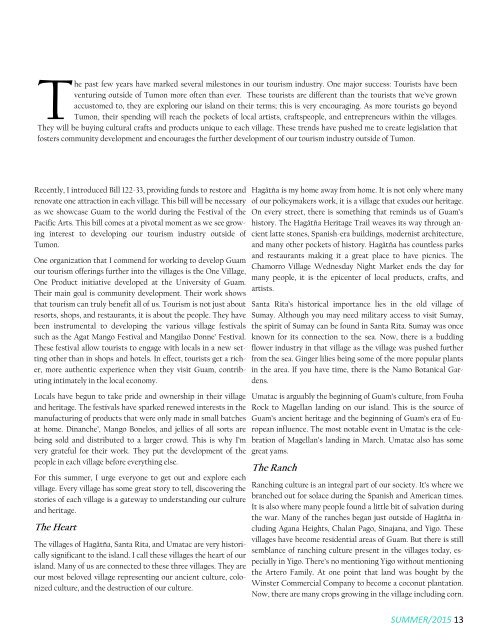Create successful ePaper yourself
Turn your PDF publications into a flip-book with our unique Google optimized e-Paper software.
T<br />
he past few years have marked several milestones in our tourism industry. One major success: Tourists have been<br />
venturing outside of Tumon more often than ever. These tourists are different than the tourists that we’ve grown<br />
accustomed to, they are exploring our island on their terms; this is very encouraging. As more tourists go beyond<br />
Tumon, their spending will reach the pockets of local artists, craftspeople, and entrepreneurs within the villages.<br />
They will be buying cultural crafts and products unique to each village. These trends have pushed me to create legislation that<br />
fosters community development and encourages the further development of our tourism industry outside of Tumon.<br />
Recently, I introduced Bill 122-33, providing funds to restore and<br />
renovate one attraction in each village. This bill will be necessary<br />
as we showcase Guam to the world during the Festival of the<br />
Pacific Arts. This bill comes at a pivotal moment as we see growing<br />
interest to developing our tourism industry outside of<br />
Tumon.<br />
One organization that I commend for working to develop Guam<br />
our tourism offerings further into the villages is the One Village,<br />
One Product initiative developed at the University of Guam.<br />
Their main goal is community development. Their work shows<br />
that tourism can truly benefit all of us. Tourism is not just about<br />
resorts, shops, and restaurants, it is about the people. They have<br />
been instrumental to developing the various village festivals<br />
such as the Agat Mango Festival and Mangilao Donne’ Festival.<br />
These festival allow tourists to engage with locals in a new setting<br />
other than in shops and hotels. In effect, tourists get a richer,<br />
more authentic experience when they visit Guam, contributing<br />
intimately in the local economy.<br />
Locals have begun to take pride and ownership in their village<br />
and heritage. The festivals have sparked renewed interests in the<br />
manufacturing of products that were only made in small batches<br />
at home. Dinanche’, Mango Bonelos, and jellies of all sorts are<br />
being sold and distributed to a larger crowd. This is why I’m<br />
very grateful for their work. They put the development of the<br />
people in each village before everything else.<br />
For this summer, I urge everyone to get out and explore each<br />
village. Every village has some great story to tell, discovering the<br />
stories of each village is a gateway to understanding our culture<br />
and heritage.<br />
The Heart<br />
The villages of Hagåtña, Santa Rita, and Umatac are very historically<br />
significant to the island. I call these villages the heart of our<br />
island. Many of us are connected to these three villages. They are<br />
our most beloved village representing our ancient culture, colonized<br />
culture, and the destruction of our culture.<br />
Hagåtña is my home away from home. It is not only where many<br />
of our policymakers work, it is a village that exudes our heritage.<br />
On every street, there is something that reminds us of Guam’s<br />
history. The Hagåtña Heritage Trail weaves its way through ancient<br />
latte stones, Spanish-era buildings, modernist architecture,<br />
and many other pockets of history. Hagåtña has countless parks<br />
and restaurants making it a great place to have picnics. The<br />
Chamorro Village Wednesday Night Market ends the day for<br />
many people, it is the epicenter of local products, crafts, and<br />
artists.<br />
Santa Rita’s historical importance lies in the old village of<br />
Sumay. Although you may need military access to visit Sumay,<br />
the spirit of Sumay can be found in Santa Rita. Sumay was once<br />
known for its connection to the sea. Now, there is a budding<br />
flower industry in that village as the village was pushed further<br />
from the sea. Ginger lilies being some of the more popular plants<br />
in the area. If you have time, there is the Namo Botanical Gardens.<br />
Umatac is arguably the beginning of Guam’s culture, from Fouha<br />
Rock to Magellan landing on our island. This is the source of<br />
Guam’s ancient heritage and the beginning of Guam’s era of European<br />
influence. The most notable event in Umatac is the celebration<br />
of Magellan’s landing in March. Umatac also has some<br />
great yams.<br />
The Ranch<br />
Ranching culture is an integral part of our society. It’s where we<br />
branched out for solace during the Spanish and American times.<br />
It is also where many people found a little bit of salvation during<br />
the war. Many of the ranches began just outside of Hagåtña including<br />
Agana Heights, Chalan Pago, Sinajana, and Yigo. These<br />
villages have become residential areas of Guam. But there is still<br />
semblance of ranching culture present in the villages today, especially<br />
in Yigo. There’s no mentioning Yigo without mentioning<br />
the Artero Family. At one point that land was bought by the<br />
Winster Commercial Company to become a coconut plantation.<br />
Now, there are many crops growing in the village including corn.<br />
SUMMER/2015 13





